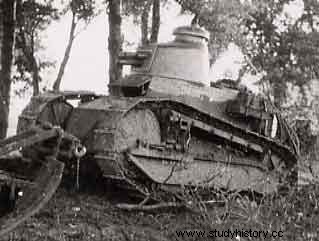FT-17 cannon Renault FT-17
General characteristics
Crew 2 (commander and pilot)
Length 4.95m
Width 1.73m
Height 2.13m
Combat mass 6.7 tons
Armor and armament
Shielding 6 to 22 mm
Main armament 37mm SA18 gun
Mobility
Renault engine, 4.48 liter 4 cyl petrol
35 hp ( kW)
Road speed 8 km/h
Specific power 5 hp/tonne
Autonomy 35 km

The Renault FT-17 is the most famous French tank of the First World War. It was produced nearly 3500 copies, enormously influenced the arms industry around the world by fixing the very type of the battle tank, by the use of an armament in turret. It remained in service with the French army until the beginning of the Second World War, and was even used later by the Wehrmacht for occupation and training tasks.
To complete the range of Schneider or Saint-Chamond tanks experienced in 1916, Colonel Estienne, organizer of aviation but also father of the French combat tank, recommended light armor.
The Renault FT-17 tracked armored car was that one. It was a revolutionary tank. The FT-17 was the first to be equipped with a 360° rotating turret. Such turrets became classic and were used on most tanks until today.
The studies began in May 1916, the prototype was built at the beginning of July 1917 and it is estimated that more than 3,800 specimens were produced, in any case, at least 3,177. These tanks had a turret initially rounded and molded, later octagonal and riveted or later still, a riveted round turret called the Berliet turret. In the United States were built under license 950 copies, most of them after the war.
If the number of the FT-17 tank represents the year 1917 when it was created, the letters FT were the subject of fanciful interpretations:Low Tonnage, Low Size or even Crossing Trenches. If these names represent good mnemonics, they do not however stick to the reality which is more banal:it is quite simply a chronological code of Renault production at the time. The previous model was FS and the next FU. The latter being, moreover, a truck intended for the transport of the Renault FT-17.
Very rustic compared to the tanks of the 1930s that it saw during the Second World War, this tank was maneuvered by a crew of two, a tank commander/gunner and a driver, the tank commander being located standing behind the driver. Due to the absence of an internal communication system - and thanks to the absence of a partition between the driver's compartment and the turret - the tank commander gave his orders to the driver by pressing either of his knees against his back to change direction, and tapping his helmet to start or stop.
It was also characterized by the hardness, even quasi-absence, of its suspension. During crossings, the driver had to play with the clutch and the brake to avoid causing the tank to suddenly fall forward, which would have risked causing damage to his spine. Likewise, off-road he had to be extremely careful because of the narrowness of the body which, combined with a fairly high center of gravity, could easily lead to a side tipping and overturning.
Commitments
The tank was very widely used (also by the Americans) during the First World War, from May 31, 1918. It was the best designed tank of the whole war, economical and suitable for mass production.
After the war it was exported to many countries (Finland, Estonia, Lithuania, Poland, Romania, Yugoslavia, Czechoslovakia, Switzerland, Spain, Belgium, the Netherlands, Brazil, Republic of China, Japan, and Iran). Thus the FT-17 tanks were used by the majority of the countries having an armored force, as main tank. They took part in many later conflicts such as Russian Civil War, Polish-Soviet War, Chinese Civil War, Spanish Civil War. Italy produced an almost identical tank, the FIAT 3000. The FT-17 tanks were also used during the Second World War, among others by France and Poland, although they are completely obsolete. There were still 2,850 of them on September 1, 1939, in the French army, and the Wehrmacht recovered 1,704 copies at the armistice of 1940.
Variants
* FT-17 with a Hotchkiss Mle 1914 8 mm machine gun (4,800 rounds) - about 3/5 of the tanks produced.
* FT-17 with a short 37 mm Puteaux SA-18 gun - about 1/3 of the tanks produced. Manufactured between 1918 and 1919, it is also known as FT-18 and sold under this name for export. least 39 tanks.
* TSF - command tank equipped with radio, no armament, 3 crew, at least 188 produced.
* FT-17 with 7.5 mm Reibel Châtellerault MAC31 machine gun - 1580 modified pre WWII from 1931.
* Six Ton Tank Model 1917 - USA produced copy . Used by the US Marines Corps and Canada.
* Fiat 3000:Italian copy used in the 1920s.
Manufacturer:commands under construction November 11, 1918:Renault 1850 copies, Berliet 800, Somua 600, Delauney-Belleville 280
probably 3,694 copies
Production period:1917 to 1918
Rotation:360°
Elevation:+ 35° to - 20°
Consumption:30 l per 100 km
Track width:0.34 m
Ground clearance:0.43 m
Vertical obstacle:0.60m
Slope:10°
Fording:0.70 m
Crossing:1.35 m
